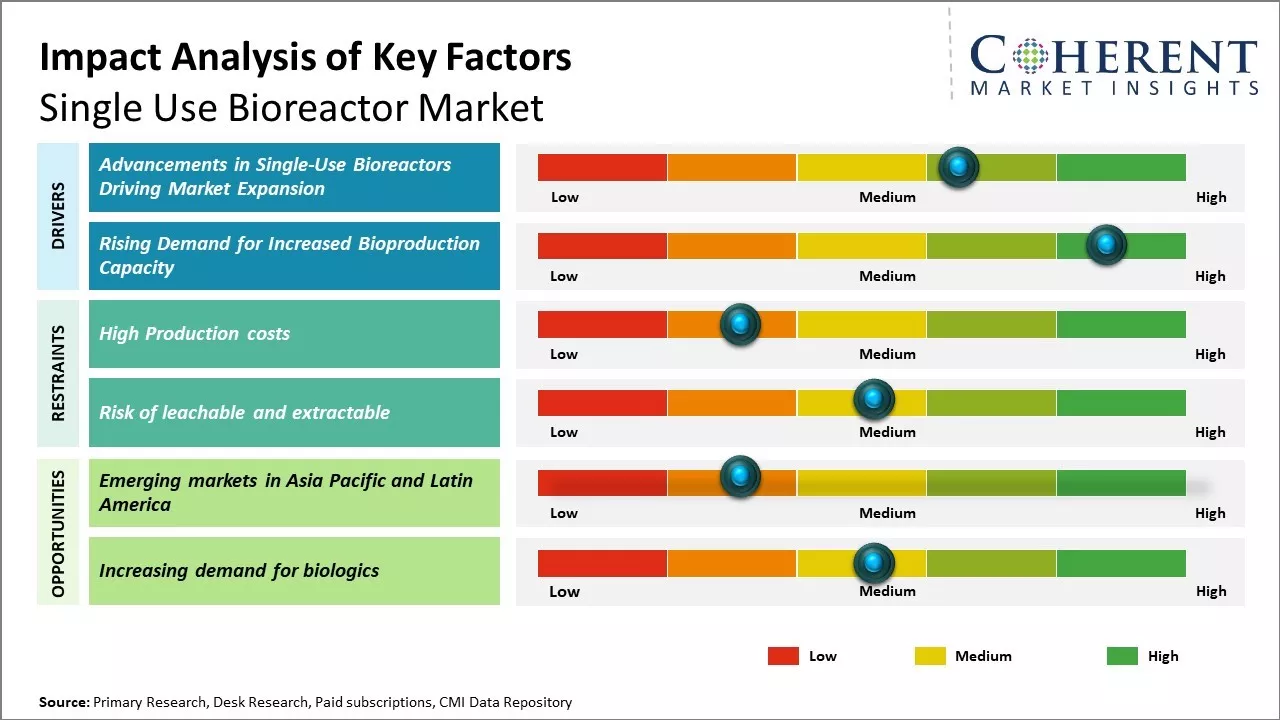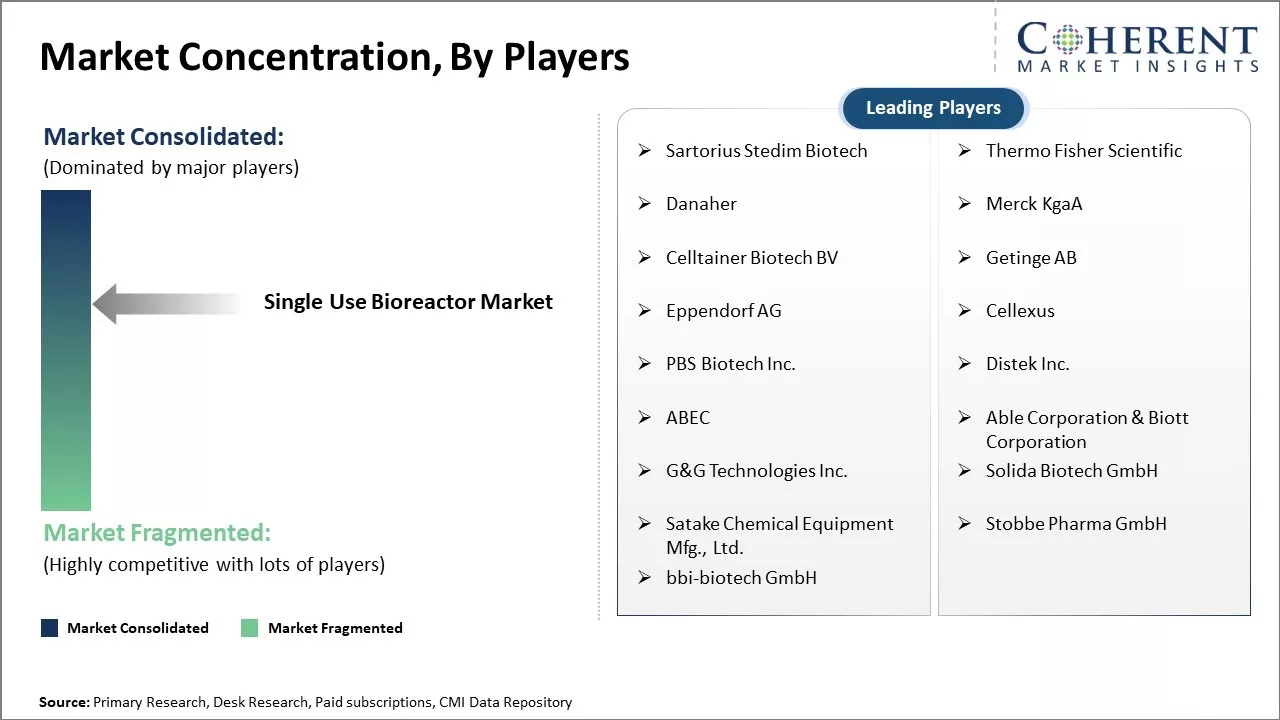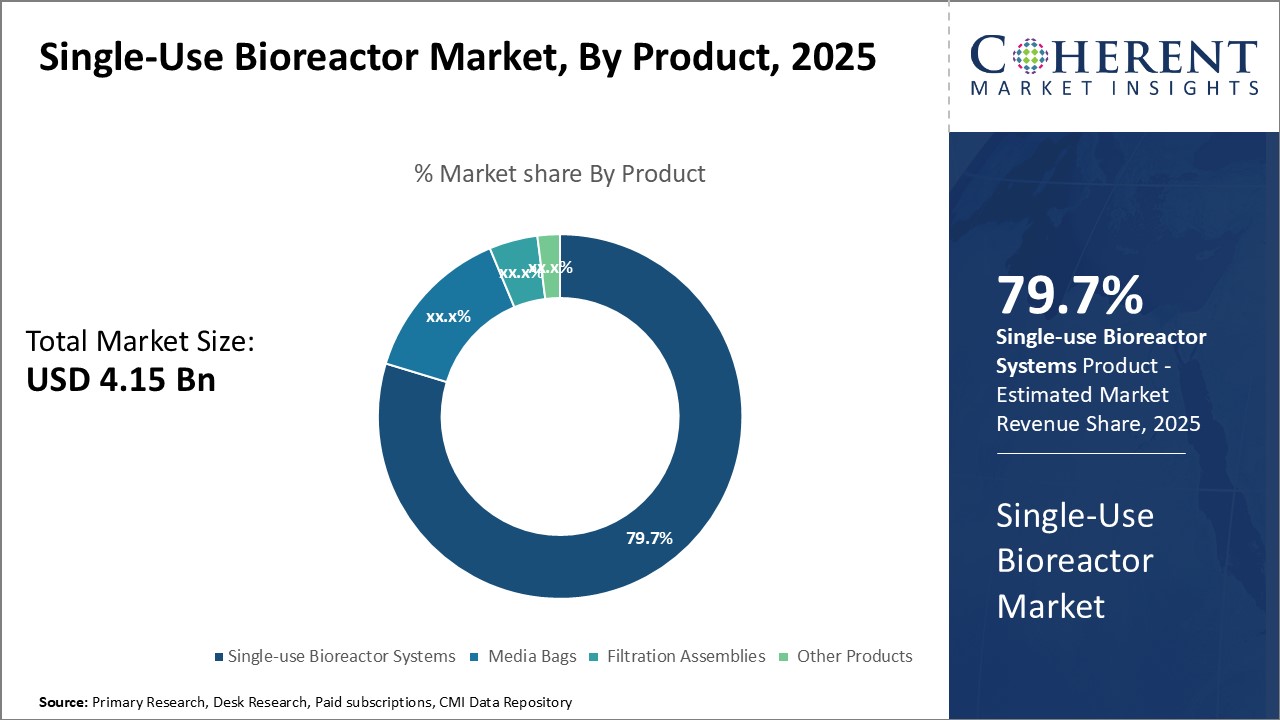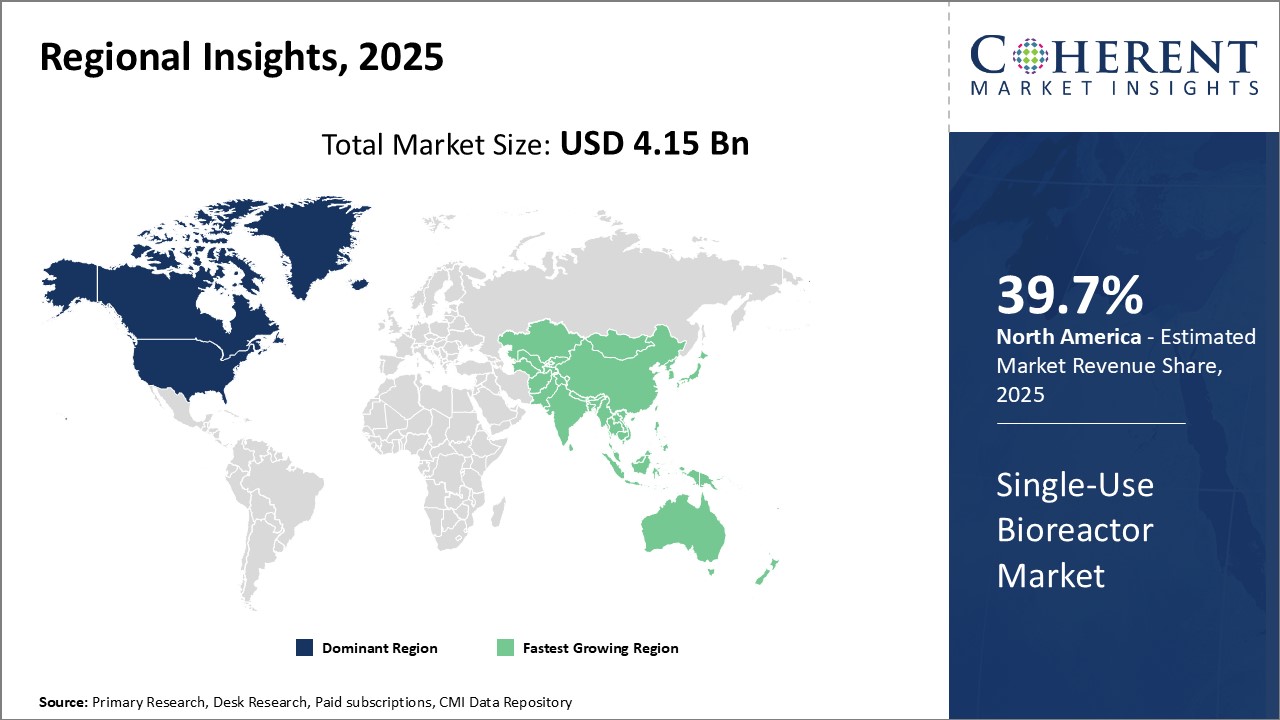The Single Use Bioreactor Market is estimated to be valued at USD 4.15 Billion in 2025 and is expected to reach USD 13.38 Billion by 2032, exhibiting a compound annual growth rate (CAGR) of 18.2% from 2025 to 2032.

Discover market dynamics shaping the industry: Download Free Sample
The market growth is driven by growth in the biopharmaceutical industry and advantages of single-use technologies over stainless steel bioreactors. The trend in the single use bioreactor market has been rising adoption rates across small companies and contract manufacturing organizations. Traditionally, large biopharma companies were the primary adopters of single-use bioreactors due to high capital investment required for stainless steel bio reactors. However, small biotech startups and contract pharma manufacturing players now see single-use bioreactors as advantageous due to low installation and maintenance costs. This has allowed these entities to benefit from the flexibility of single-use bioreactors. Going forward, this trend is expected to continue and drive the market growth during the forecast period.
Advancements in Single-Use Bioreactors
The demand for single-use bioreactors is growing significantly among pharmaceutical companies as they look to streamline their drug production processes. A major driver pushing this adoption is the operation and manufacturing advantages offered by single-use bioreactors over their stainless-steel counterparts. Pharmaceutical companies are dealing with greater regulatory requirements today to ensure drug safety and quality. With single-use bioreactors, they can reduce the risks of cross-contamination between different drug batches as each bioreactor is used only once. This helps improve compliance with stringent cGMP guidelines.
Noteworthy advancements are underway in the single-use bioreactor sector, driving the market expansion. For instance, in March 2021, Thermo Fisher Scientific introduced the 3,000 L and 5,000 L HyPerforma DynaDrive single-use bioreactors. These vessels share the same footprint, featuring simplified hardware optimized for perfusion cell culture processes, thereby aiding in conserving manufacturing suite space. These advancements are expected to propel the market growth in the foreseeable future.

Get actionable strategies to beat competition: Download Free Sample
Rising Demand for Increased Bioproduction Capacity
Global demand for biologics has grown substantially in recent years, driven by the expanding markets for vaccines, monoclonal antibodies, and other biomolecules. As biopharmaceutical pipelines continue delivering promising new drug candidates, the need to scale up biomanufacturing capabilities is increasingly crucial. However, building additional stainless-steel facilities requires sizable capital investments and can take 2-3 years to complete. In contrast, single-use bioreactors provide a faster and more cost-effective means to accelerate bioproduction without significant facility expansion. Their implementation can help gain vital biomanufacturing capacity within a much shorter timeframe to better address market needs. By offering a highly scalable approach, single-use bioreactors have enabled facilities to smoothly transition production volumes across different batch and product sizes. Their modular, standardized design allows for more predictable scale-up studies compared to conventional systems.
Key Takeaways
The single use bioreactor market is experiencing strong growth driven by increasing adoption in manufacturing of biopharmaceuticals. Biopharma companies are leveraging single use bioreactors as they provide increased flexibility and save on validation and cleaning costs compared to stainless steel bioreactors. North America currently dominates the market due to presence of major biopharma players while Asia Pacific is expected to be the fastest growing region over the forecast period.
While single use bioreactors offer significant advantages, initial capital investment can be higher than conventional glass and stainless-steel bioreactors. Additionally, concerns around extractables and leachable from disposable bioreactor components may hamper market growth. However, advances in material science are resolving many of these issues. The development of novel surfaces and materials for single use bioreactors also presents an opportunity for vendors.
With the rise of personalized medicine and demand for biosimilars, contract manufacturing organizations are expanding production capacity by leveraging single use bioreactors. Their modular, scalable and deployable nature makes them an attractive solution for CMOs. Going forward, the availability of customized single use bioreactor solutions catered for specific manufacturing workflows will further support market growth.
Market Challenges: High Production costs
The single-use bioreactor market currently faces some challenges. Production costs are still relatively high compared to stainless steel bioreactors, although the price differential is narrowing as single-use technologies gain more widespread adoption. There are also concerns from some biopharmaceutical companies around reliability and consistency of performance from bag to bag. Ensuring sterility during assembly and operation also adds complexity. Standardization across suppliers is another challenge area that could help reduce costs if realized.
Market Opportunities: Rising Biologics Demand Spurs Single-Use Bioreactor Integration
The single-use bioreactor market also presents substantial opportunities. As the baby-boomer generation ages, demand for biologics will continue growing rapidly. Their advantages of speed and flexibility make single-use technologies particularly appealing for emerging applications like personalized and oral vaccines. Their compact footprint also enables distributed manufacturing models. If production costs decrease further and reliability concerns are addressed, the complete integration of single-use bioreactors into mainstream bioprocessing workflows seems inevitable.

Discover high revenue pocket segments and roadmap to it: Download Free Sample
Insights, by product: Increasing Adoption of Single-Use Technologies
In terms of Product, the Single-use Bioreactor Systems segment is estimated to hold the highest share of 79.7% in 2025 wing to their increasing adoption across small-mid-sized biopharmaceutical manufacturers. Single-use bioreactor systems offer significant advantages over stainless steel counterparts including reduction in validation efforts and capital costs. They eliminate cleaning and sterilization steps between production batches, thereby increasing manufacturing flexibility and throughput. The use of pre-assembled and gamma-sterilized single-use bags also reduces the risks of cross-contamination. With growing demand for personalized medicines and preference for smaller batch sizes, single-use bioreactor systems help organizations to achieve faster product development and market launch.
Insights, by Cell Type: Growing Focus on Mammalian Cell Culture Production
In terms of Cell Type, the Mammalian Cell segment is estimated to hold the highest share of 40.73% in 2025 driven by its widespread use in vaccine and antibody production. A majority of clinically approved biosimilars, recombinant proteins and monoclonal antibodies are developed using mammalian cell lines like CHO cells. They allow for human-like post-translational modifications of proteins which bacteria or yeast cannot replicate. With rising demand for biologics, biopharmaceutical manufacturers are focusing on increasing production capacities for mammalian cell culture-based biologics. This in turn is positively impacting the growth of single-use bioreactors optimized for mammalian cell culture processes.
Insights by Molecule Type: Surging Demand for Monoclonal Antibody Therapeutics
In terms of Molecule Type, the Monoclonal Antibodies segment is estimated to hold the highest share of 40.63% in 2025 owing to the rising popularity of antibody drugs across various disease indications. Monoclonal antibodies have emerged as a major category of biologics in the last decade with more than 80 FDA-approved mAbs. Their target specificity and favorable safety profiles have broadened their therapeutic applications in oncology, immunology and infectious diseases. With robust clinical pipeline and continued approvals, demand for manufacturing capacities of mAbs is surging. Leading players are heavily investing in single-use bioreactor technologies optimized for high yield production of monoclonal antibody therapeutics to support their commercial requirements.

Need a Different Region or Segment? Download Free Sample
North America has established itself as the dominant region in the single use bioreactor market with highest share of 39.7% in 2025. The U.S., in particular, boasts a large presence of leading biopharmaceutical manufacturers that have made significant investments in advanced biomanufacturing capabilities using single use bioreactors. This is primarily due to stricter regulation around sterility and validation in the pharma industry in the U.S. The FDA's focus on producing biologics under aseptic conditions safely and effectively has spurred widespread adoption of single use systems that eliminate complex and costly cleaning and validation requirements of conventional stainless-steel bioreactors.
The Asia Pacific region is emerging as the fastest-growing market for single use bioreactors globally. Countries such as China, India, Japan, and South Korea house a significant number of generic drug manufacturers as well as new entrants in the biosimilars space. These companies are under commercial pressure to rapidly scale up production at lower costs using disposable technologies. With the demand for biopharmaceuticals and vaccines rising rapidly across Asia due to a growing population and changing disease landscapes, local manufacturers are choosing single use systems in order to fast track facility builds and come online faster.
Single-Use Bioreactor Market Report Coverage
| Report Coverage | Details | ||
|---|---|---|---|
| Base Year: | 2024 | Market Size in 2025: | USD 4.15 Bn |
| Historical Data for: | 2020 To 2024 | Forecast Period: | 2025 To 2032 |
| Forecast Period 2025 to 2032 CAGR: | 18.2% | 2032 Value Projection: | USD 13.38 Bn |
| Geographies covered: |
|
||
| Segments covered: |
|
||
| Companies covered: |
Sartorius Stedim Biotech, Thermo Fisher Scientific, Danaher, Merck KgaA, Celltainer Biotech BV, Getinge AB, Eppendorf AG, Cellexus, PBS Biotech Inc., Distek Inc., ABEC, Able Corporation & Biott Corporation, G&G Technologies Inc., Solida Biotech GmbH, Satake Chemical Equipment Mfg., Ltd., Stobbe Pharma GmbH, and bbi-biotech GmbH |
||
| Growth Drivers: |
|
||
| Restraints & Challenges: |
|
||
Uncover macros and micros vetted on 75+ parameters: Get instant access to report
Share
Share
About Author
Nikhilesh Ravindra Patel is a Senior Consultant with over 8 years of consulting experience. He excels in market estimations, market insights, and identifying trends and opportunities. His deep understanding of the market dynamics and ability to pinpoint growth areas make him an invaluable asset in guiding clients toward informed business decisions. He plays a instrumental role in providing market intelligence, business intelligence, and competitive intelligence services through the reports.
Missing comfort of reading report in your local language? Find your preferred language :
Transform your Strategy with Exclusive Trending Reports :
Frequently Asked Questions
Joining thousands of companies around the world committed to making the Excellent Business Solutions.
View All Our Clients